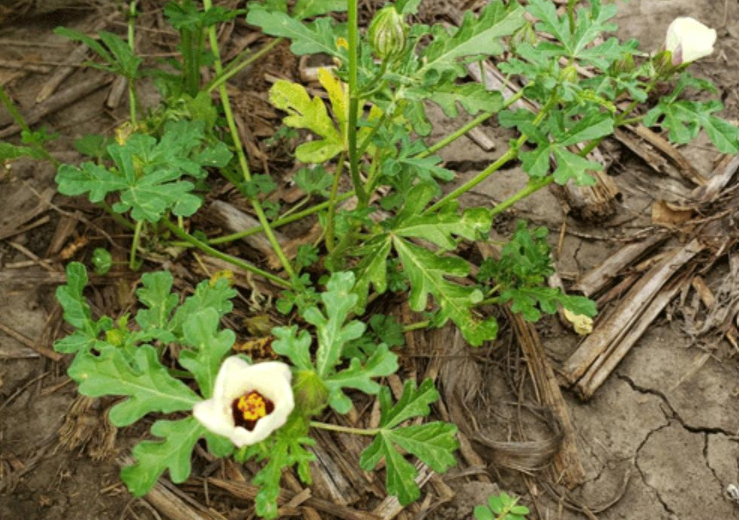
By STACY CAMPBELL
Cottonwood Extension District
Venice mallow (Hibiscus trionum). This attractive annual species is also called “flower-of-an-hour” because each flower remains open for just a few hours before being shed. Venice mallow is in the Malvaceae family, and is related to velvetleaf and common mallow, as well as cotton. The species name trionum refers to the normally three-lobed appearance of the leaves.
Ecology
Venice mallow is an introduced plant that has become naturalized in much of the United States. A native of southern Europe, the plant was introduced as an ornamental before escaping cultivation to become a weed. The species is most prevalent in the eastern part of Kansas, but can occur anywhere within the state. It can be found in gardens, cultivated fields, waste areas, pastures, and roadways.
Identification
Venice mallow is an annual species reproducing by seeds. It normally grows 0.5 to 2 feet tall, with its many branches often spreading out from the base prior to curving upward. The stems are covered with stiff, short hairs. Leaves are alternate and borne on stalks (petioles), with hairs on the lower surfaces but generally smooth on the top surfaces. The cotyledon (seed) leaves are heart-shaped, and the first true leaves are rounded with gently lobed edges. Subsequent true leaves are normally deeply divided into three lobes, but may have as many as seven lobes (Figure 1). The center lobe is longer than the side lobes, but all are gently lobed to toothed along the edges.
Flowers are up to 2.5 inches wide, are short-lived, and originate from petioles arising from the junction of the stem and leaf petioles. The flowers have five petals, are white to pale yellow, and have a reddish to dark purple center. Seeds are produced in a globe-shaped capsule surrounded by a papery husk called a calyx (Figure 1). At maturity, the calyx and capsule dry and rupture, exposing the small (0.1 inch) seeds, which are kidney-shaped, dark brown, and rough.
Because Venice mallow is an indeterminate plant, flowers and seeds are produced throughout the growing season until a killing frost in the fall. Like its close relative, velvetleaf, Venice mallow seeds have an extremely hard seed coat. Consequently, seeds may lie dormant for many years, even decades, before emerging.
Management
Historically, it was most often problematic in soybean production areas in Kansas. In recent years, newer herbicides and herbicide-resistant soybean varieties have reduced its prevalence in the crop. Herbicides which effectively control Venice mallow in soybean include 2,4-D (Group 4), glyphosate (Group 9), and glufosinate (Group 10) in herbicide-resistant varieties, as well as Group 14 herbicides (sulfentrazone, saflufenacil, flumioxazin) and Group 15 herbicides (pyroxasulfone) in conventional soybean. Group 4 herbicides (2,4-D, dicamba, fluroxypyr) can be used if Venice mallow occurs in corn or sorghum.
Integrated weed management techniques should be the first line of defense when dealing with any weed situation, and this is particularly true in crops such as sunflowers, cotton, or dry beans.
With fewer herbicides available to control Venice mallow and other weeds in these crops, prevention as well as mechanical and cultural control practices are even more important. With the longevity of Venice mallow seed viability, attention should be given to the prevention of seedset and movement of seed from infested fields to clean fields.
Information provided by Patrick Geier and Sarah Lancaster, K-State Extension Weed Management Specialists.
Stacy Campbell is a Crop Production Extension agent in the Cottonwood District (which includes Barton and Ellis counties) for K-State Research and Extension. You can contact him by e-mail at [email protected] or by calling 785-628-9430.






